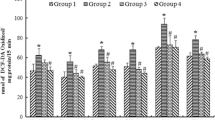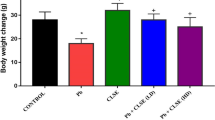Abstract
In the present study, the effects of chitosan on erythrocyte malondialdehyde (MDA) and glutathione (GSH) levels and glutathione peroxidase (GSH-Px), glutathione reductase (GR), and glucose-6-phosphate dehydrogenase (G6PDH) enzyme activities in lead toxicity-induced rats were investigated. Twenty-eight male Wistar albino rats were divided into four groups of control (C), lead group (Pb group), lead + chitosan group (Pb + CS group), and chitosan group (CS group). Lead groups were administered 50 mg/kg lead acetate intraperitoneally (ip) for 5 days and chitosan groups were administered 200 mg/kg chitosan for 28 days via gavage. At the end of the study, lead levels were measured in the blood; MDA and GSH levels and GPx, GR, and G6PDH activities were measured in the erythrocyte. It was determined that, in parallel with the increase of full blood lead levels in the Pb group, erythrocyte MDA levels increased significantly, while GSH levels and GSH-Px, GR, and G6PDH activities decreased when compared to those in the C and CS groups (p ˂ 0.05). There was a statistically significant decrease in lead and MDA levels and GSH level and GSH-Px activity increased (p ˂ 0.05) in the Pb + CS group, where chitosan was administered as a protective agent in addition to lead, when compared to the Pb group. There were no differences between the Pb + CS group and the other three groups based on GR and G6PDH activities (p ˃ 0.05). No statistically significant difference was found between the C and CS groups based on the parameters of analysis (p ˃ 0.05). The findings of the present study demonstrated that lead increased oxidative stress by increasing free radical production in erythrocytes, and chitosan was effective in removing the lead from the circulation and enforced the antioxidant defense system.
Similar content being viewed by others
References
Ercal N, Gurer-Orhan H, Aykin-Burns N (2001) Toxic metals and oxidative stress part I: mechanisms involved in metal-induced oxidative damage. Curr Top Med Chem 1(6):529–539
Barbarosa F Jr, Tanus-Santos JE, Gerlach RF, Parsons PJ (2005) A critical review of biomarkers used for monitoring human exposure to lead: advantages, limitations and future needs. Environ Health Perspect 113(12):1669–1674
Komousani TA, Moselhy SS (2011) Modulation of lead biohazards using a combination of epicatechin and lycopene in rats. Hum Exp Toxicol 30(10):1674–1681
Dundar Y, Aslan R (2000) Oxidative stress and antioxidants in medicine. Afyon Kocatepe University Publications, Afyon
Rehman S (2013) Effect of lead on lipid peroxidation, phospholipids composition, and methylation in erythrocyte of human. Biol Trace Elem Res 154(3):433–439
Çaylak E (2010) Lead toxication and oxidative stress in children and antioxidant effects of thiol compounds. J Dent Child 10(1):13–23
Smith DL, Harris AD, Johnson JA, Silbergeld EK, Morris JG (2002) Animal antibiotic use has an early but important impact on the emergence of antibiotic resistance in human commensal bacteria. Proc Natl Acad Sci 99(9):6434–6439
Wu KY, Wu M, Fu ML, Li H, Yang Y, Zhang H, Cheng C, Wang ZZ, Wang XY, Lü XB, Liu DG, Li H, Gao R (2006) A novel chitosan CpG nanoparticle regulates cellular and humoral immunity of mice. Biomed Environ Sci 19(2):87–95
Wang Z, Yan Y, Yu X, Li W, Li B, Qin C (2016) Protective effects of chitosan and its water-soluble derivatives against lead-induced oxidative stress in mice. Int J Biol Macromol 83:442–449
Mutlu N, Ersan Y, Nur G, Koç E (2011) Protective effect of caffeic acid phenethyl ester against lead acetate-induced hepatotoxicitiy in mice. Kafkas Univ Vet Fak Derg. https://doi.org/10.9775/kvfd.2010.2717
Jeon TI, Hwang SG, Park NG, Jung YR, Shin SI, Choi SD, Park DK (2003) Antioxidative effect of chitosan on chronic carbon tetrachloride induced hepatic injury in rats. Toxicology 187(1):67–73
Leggett RW (1993) An age-specific kinetic model of lead metabolism in humans. Environ Health Perspect 101:598–616
Çaylak E, Aytekin M, Halifeoglu I (2008) Antioxidant effects of methionine, alpha-lipoic acid, N-acetylcysteine and homocysteine on lead-induced oxidative stress to erythrocytes in rats. Exp Toxicol Patho 60(4–5):289–294
Ercal N, Treeratphan P, Lutz P, Hammond TC, Matthews RH (1996) N-actylcysteine protects Chinese hamster ovary (CHO) cells from lead-induced oxidative stress. Toxicology 108(1–2):57–64
Gürer H, Özgüneş H, Neal R, Spitz RD, Erçal N (1998) Antioxidant effects of N-acetylcysteine and succimer in red blood cells from lead-exposed rats. Toxicology 128(3):181–189
Aykin-Burns N, Laegeler A, Kellogg G, Ercal N (2003) Oxidative effects of lead in young and adult Fisher 344 rats. Arch Environ Contam Toxicol 44(3):417–420
Hsu JM (1981) Lead toxicity as related to glutathione metabolism. J Nutr 37:26–33
Ribarov SR, Benov LC, Benchev IC (1981) The effect of lead on hemoglobin catalyzed lipid peroxidation. Biochim Biophys Acta 664:453–550
Clemens MR, Waller HD (1987) Lipid peroxidation in erythrocytes. Chem Phys Lipids 45:251–268
Gürer H, Özgüneş H, Öztezcan S, Erçal N (1999) Antioxidant role of α-lipoic acid in lead toxicity. Free Radic Biol Med 27(1–2):75–81
Gürer H, Özgüneş H, Saygın E, Ercal N (2001) Antioxidant effect of taurine against lead-induced oxidative stress. Environ Contam Toxico l41(4):397–402
Lee MK, Cho SY, Kim DJ, Jang JY, Shin KH, Park SA, Park EM, Lee JS, Choi MS, Lee JS, Kim MJ (2005) Du-zhong (Eucommia ulmoides Oliv.) cortex water extract alters heme biosynthesis and erythrocyte antioxidant defense system in lead administered rats. J Med Food 8(1):86–92
Li HW, Deng JG, Du ZC, Yan MS, Long ZX, Pham Thi PT, Yang KD (2013) Protective effects of mangiferin in subchronic developmental lead-exposed rats. Biol Trace Elem Res 152(2):233–242
Yoshida A, Huang IY (1986) Structure of human glucose-6-phosphate dehydrogenase. In: Yoshida A, Beutler E (eds) Glucose-6-phosph ate dehydrogenase. Academic Press, New York, pp 473–482
Valle BL, Ulmer DD (1972) Biochemical effects of mercury, cadmium and lead. Annu Rev Biochem 41:91–128
Lachant NA, Tomoda A, Tanaka KR (1984) Inhibition of the pentose phosphate shunt by lead: a potential mechanism for hemolysis in lead poisoning. Blood 63:518–524
Gelman BB, Michaelson IA, Bus JS (1978) The effect of lead on oxidative hemolysis and erythrocyte defense mechanisms in the rat. Toxicol Appl Pharmacol 45:119–129
Calderon-Salinas V, Hernandez-Luna C, Maldonado MV, Saenz DR (1993) Mechanisms of the toxic effect of lead. I. Free lead in erythrocyte. J Expo Anal Environ Epidemiol 3:153–164
Howard JK (1974) Human erythrocyte glutathione reductase and glucose 6-phosphate dehydrogenase activities in normal subjects and in persons exposed to lead. Clin Sci Mol Med 47:515–520
Rausa G (1969) Behavior of erythrocyte glucose-6-phosphate dehydrogenase in rats treated subcutaneously with lead acetate. Chem Abstr 71:125
Rogers LE, Battles ND, Reimold EW, Sartain P (1971) Erythrocyte enzymes in experimental lead poisoning. Arch Toxikol 28:202–207
Fahey RC, Sundquist AR (1991) Evolution of glutathione metabolism. Adv. Enzymol. Relat. Areas Mol Biol 64:1–53
Sandhir R, Julka D, Gill KD (1994) Lipoperoxidative damage on lead exposure in rat brain and its implications on membrane bound enzymes. Pharmacol Toxicol 74:66–71
Sandhir R, Gill KD (1995) Effect of lead on lipid peroxidation in liver of rats. Biol Trace Elem Res 48:91–97
Bompart G, Orfila C (1990) Cisplatin nephrotoxicity in lead-pretreated rats: enzymatic and morphological studies. Toxicol Lett 50(2–3):237–247
Eshginia S, Marjani A (2013) Effect of vitamin C on the erythrocyte antioxidant enzymes in ıntoxicated-lead rat off springs. J Clin Diagn Res 7(6):1078–1081
Sivaprasad R, Nagaraj M, Varalakshmi P (2004) Combined efficacies of lipoic acid and 2,3-dimercaptosuccinic acid against lead-induced lipid peroxidation in rat liver. J Nutr Biochem 15:18–23
Soltaninejad K, Kebriaeezadeh A, Minaiee B, Ostad SN, Hosseini R, Azizi E (2003) Biochemical and ultrastructural evidences for toxicity of lead through free radicals in rat brain. Hum Exp Toxicol 22:417–423
Sun T, Yao Q, Zhou D, Mao F (2008) Antioxidant activity of N-carboxymethyl chitosan oligosaccharides. Bioorg Med Chem Lett 18(21):5774–5776
Yuan WP, Liu B, Liu CH, Wang XJ, Zhang MS, Meng XM, Xia XK (2009) Antioxidant activity of chito-oligosaccharides on pancreatic islet cells in streptozotocin-induced diabetes in rats. World J Gastroenterol 15(11):1339–1345
Anandan R, Nair PG, Mathew S (2004) Anti-ulcerogenic effect of chitin and chitosan on mucosal antioxidant defence system in HCl-ethanol-induced ulcer in rats. J Pharm Pharmacol 56(2):265–269
Ramasamy P, Subhapradha N, Shanmugam V, Shanmugam A (2014) Protective effect of chitosan from Sepia kobiensis (Hoyle 1885) cuttlebone against CCl4 induced hepatic injury. Int J Biol Macromol. https://doi.org/10.1016/j.ijbiomac.2014.02.009
Subhapradha N, Saravanan R, Ramasamy P, Srinivasan A, Shanmugam V, Shanmugam A (2014) Hepatoprotective effect of β-chitosan from gladius of sepioteuthis lessoniana against carbon tetrachloride-ınduced oxidative stress in Wistar rats. Appl Biochem Biotechnol 172(1):9–20
Ma Y, Huang Q, Lv M, Wu Z, Xie Z, Han X, Wang Y (2014) Chitosan-Zn chelate increases antioxidant enzyme activity and improves immune function in weaned piglets. Biol Trace Elem Res 158(1):45–50
Acknowledgements
This study was sponsored by Yuzuncu Yil University Scientific Research Project Fund and registered under project No: 2015-SBE-YL049.
Author information
Authors and Affiliations
Corresponding author
Rights and permissions
About this article
Cite this article
Toz, H., Değer, Y. The Effect of Chitosan on the Erythrocyte Antioxidant Potential of Lead Toxicity-Induced Rats. Biol Trace Elem Res 184, 114–118 (2018). https://doi.org/10.1007/s12011-017-1164-2
Received:
Accepted:
Published:
Issue Date:
DOI: https://doi.org/10.1007/s12011-017-1164-2




